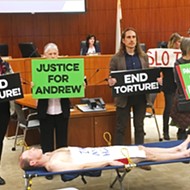[{
"name": "Ad - Medium Rectangle CC01 - 300x250",
"id": "AdMediumRectangleCC01300x250",
"class": "inlineCenter",
"insertPoint": "8",
"component": "2963441",
"requiredCountToDisplay": "12"
},{
"name": "Ad - Medium Rectangle LC01 - 300x250",
"id": "AdMediumRectangleCC01300x250",
"class": "inlineCenter",
"insertPoint": "18",
"component": "2963441",
"requiredCountToDisplay": "22"
},{
"name": "Ad - Medium Rectangle LC09 - 300x250",
"id": "AdMediumRectangleLC09300x250",
"class": "inlineCenter",
"insertPoint": "28",
"component": "3252660",
"requiredCountToDisplay": "32"
}]
Despite a 13-year career in law enforcement, Brian Hedley said it was difficult to watch the video footage of Andrew Holland dying in a glass-walled cell at the SLO County jail.
One of two private investigators hired by the Holland family's attorney to dig into the 36-year-old schizophrenic man's death, Hedley said he watched the footage multiple times. In total, he estimated he's seen more than 100 hours of video related to the case.
"I've seen him die at least 20 times," Hedley told New Times.
Hedley is one of a handful of people who have seen some or all of the footage documenting Holland's Jan. 22 death, which occurred after he was strapped in a restraint chair for 46 hours. While the footage was viewed by Hedley, SLO County Sheriff's Office investigators, multiple members of the Holland family, and at least one member of the SLO County Board of Supervisors, county officials have refused to release the footage to the media or the public, despite calls from Holland's family to do so.
That footage, the family claims, contains evidence showing that jail and medical staff failed to adhere to proper policy and procedure while he was in their care.
"Once you have seen the video I challenge any of you to make the argument that Andrew's death was not both needless and torturous," Ron Holland, a member of Holland's extended family, told members of the Board of Supervisors at an Aug. 22 meeting.
According to Hedley, the footage of Holland's death comes from multiple cameras inside the jail. The video is in color, but there is no sound.
The footage Hedley reviewed began with Holland inside a solitary confinement cell at the SLO County Jail. That portion appears to show the self-harming behavior that sheriff's officials said prompted them to remove Holland and place him in the chair.
"You can see him bringing his hands to his face," Hedley said. "You can see some blood trickle down his face."
When correctional deputies removed Holland from his cell, Hedley said the footage shows he was compliant and non-combative, even voluntarily placing his hands through a food slot in the door so they could be handcuffed.
The instance is one of several moments Hedley and members of Holland's family point to as evidence of their claims that, throughout the ordeal, the mentally ill Holland did not attempt to fight the jail's correctional staff, leading them to question why he was held in the chair for 46 hours. Hedley said that Holland remained compliant even as he was strapped into the restraint chair.
"He sat in the chair just as if he was going to school," Hedley said.
In an email to New Times, SLO County 3rd District Supervisor Adam Hill said he also viewed portions of the footage and that it appeared Holland wasn't combative toward the staff.
"In the video footage I saw, he was removed from his cell because he was striking himself, hitting his face, and drawing blood," Hill wrote. "After that footage he never seemed combative, but I did not see every minute, nor is there sound."
Hedley said he watched all 46 hours of footage of Holland strapped in the chair in a glass-walled holding cell in the jail's intake area. Hedley characterized Holland's state after the first five hours as "catatonic." It is during this period that he and members of Holland's family believe that jail staff failed to follow proper procedure to prevent blood clots from forming in Holland's legs as a result of being seated for such a long period of time.
According to the jail policy at the time, any inmate placed in restraints for more than two hours should receive range-of-motion exercises, in which staff are supposed to move the inmate's arms and legs for a minimum of 10 minutes every two hours.
In response to questions from New Times made shortly after the circumstances of Holland's death were made public, the Sheriff's Office said that the custody restraint policy was followed properly.
Hedley said the footage shows that the correctional deputies spent far less time moving Holland's arms and legs.
"Most of the time it's 30 seconds a limb at the most," he said.
When asked by New Times about Hedley's characterization of the time spent giving Holland the range-of-motion exercises, Hill said the description appeared to be accurate for the footage he viewed.
Final moments
For Hedley, Hill, and the members of the Holland family, the last 20 minutes or so of Holland's life is the most difficult part of the footage to watch. It begins with correctional deputies wheeling Holland into a second glass-walled cell and, according to Hedley, "unceremoniously dumping" him on its floor. Hedley says the footage clearly shows marks on Holland's arms and legs where blood has pooled. He said that it is immediately clear that Holland is in medical distress.
"From the second he hits the ground you can see he's in agony," Hedley said. "He curls up almost immediately."
While Holland is lying on the floor struggling to breath, Hedley said he was clearly visible to jail staff, claiming that the footage showed three to four correctional deputies watching him. At 5:08 p.m., Holland dies.
"You see his arms go limp and he takes his final breath," Hedley said.
The deputies then enter the cell, drag Holland to the center of it by his limp arms, and begin CPR, according to Hedley. Later, as paramedics attempt to resuscitate Holland, Hedley alleged that the footage showed some correctional deputies in the cell laughing and joking.
"It made my skin crawl," Hedley said.
Hedley's description of the footage is similar to statements made by Sherry Roy, a 52-year-old inmate who filed a claim against the county in August, stating that she suffered emotional distress after witnessing Holland's death in the jail. In her claim, Roy states that she observed correctional officers and jail staff talking and laughing "despite the dead man who lay in the cell."
Hill confirmed that the footage he watched showed two instances where jail staff may have been laughing or joking, but indicated that what the footage showed was less clear-cut.
"I am appalled that Andrew was left in the chair for so long, and I am appalled that he then died what appeared to be a very painful death after he was let out of the chair," Hill said. "But this contention about joking and laughing is very hard to confirm without sound."
Since Holland's death, neither the county nor the Sheriff's Office announced any disciplinary action taken against any correctional staff involved in Holland's death. The county's legal counsel declined to comment on the content of the footage, stating that it was confidential and part of an ongoing FBI investigation.
The county eventually agreed to a $5 million settlement with the Holland family. In the wake of the settlement, the county announced a number of changes to policy and procedure at the jail, including providing additional training for correctional officers and medical staff. The use of the restraint chair was permanently suspended.
Thus far, the county has denied public records requests for the footage, citing that it's exempt from disclosure because it could be classified as law enforcement security footage and because it's part of an ongoing FBI investigation.
Hedley and many members of the Holland family said they take issue with the county's reasons, and they've called on the county to release the footage to the public.
"San Luis Obispo County doesn't want this public because it negates everything they said about what happened," Hedley said. "The public needs to see this video."
Whatever the fate of the footage, members of Holland's family have made it clear that they don't plan to stop advocating for its public release any time soon. Many said as much to the Board of Supervisors at the Aug. 22 meeting.
"You can either choose tackle this head-on by offering the public full disclosure and the changes it demands, bearing unnecessary discomfort along the way," said Josh Holland, a cousin of Andrew Holland, "or continue to take half measures, refuse to acknowledge and speak the truth of this situation, and justifiably be held complicit by the people that entrusted you to your office." Δ
Staff Writer Chris McGuinness can be reached at [email protected].
Speaking of Holland
Latest in News
Readers also liked…
-

Coast Unified teachers upset over new position's salary and qualifications
Oct 20, 2022 -

SLO police identify alleged driver who hit and killed couple
Dec 22, 2022 -

When the levee breaks: Oceano residents, county officials walk a tightrope of regulations to manage Arroyo Grande Creek, which some say led to the levee's failure in January
May 18, 2023











